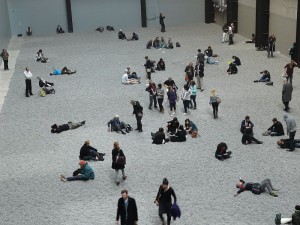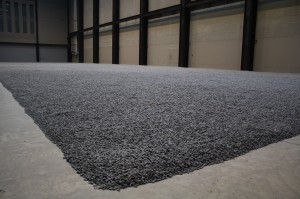Think of London, a small city, dark, dark in the daytime… Rather than sleeping in the day time Din Heagney, The Art Life’s roving International affairs editor, got out of the house and down to the Tate Modern. He writes…
A few weeks ago In London, I met up with Lily Hibberd and we trudged through the blustery weather outside into the silent behemoth of Tate Modern. After wandering around, talking about a love affair’s potential influence on art production, we decided to look at Tate’s now compromised commission by Ai Weiwei down in the Turbine Hall.
 Ai Weiwei, Sunflower Seeds, Tate Modern, 2010.
Ai Weiwei, Sunflower Seeds, Tate Modern, 2010.
Original installation view, photo: Loz Flowers
Ai Weiwei had commissioned a village in southern China to make the 12 million seeds, and each seed was given finishing strokes of paint, to give them their familiar white stripes. The entire work, in its material form at least, comments on the reliance of the modern economy on the cheap manufacture of consumables for the affluent (or as Kimmy would say, effluent). Part of the idea for Sunflower Seeds was that a bunch of white people would walk all over the cheap labour of China. It’s quite subversive really.
So we got there, then stood behind the roped off area. Nearby was a dull little sign that explained people couldn’t walk on the installation anymore. From the distant edge, we peered out into an expanse of sunflower seeds. The hand-painted porcelain sculptures covered half the floor of the industrial cavern; it felt like we were standing inside some vast grain silo. Everyone stared. It was potentially Zen. When I bent down to touch the seeds, a security guard stepped up to say, ‘don’t touch the art’. The whole experience left me rather deflated as we walked back into the sleet outside. It wasn’t meant to be like this.
As a Chinese art star, Ai Weiwei is no stranger to controversy. He gave the finger to the Bird’s Nest in the Beijing Olympics, and that was partly his own design. But the partial closure of his Sunflower Seeds in London is possibly the most neutered of recent institutional interventions into his work. As a Unilever Commission by Tate, the massive work was unveiled with much hype last October. One of the most stimulating aspects of the installation was the audience’s ability to walk on it, as Tate’s media release outlined the day before the opening: “The casual act of walking across their surface contrasts powerfully with the precious nature of the material and the effort of its production.”
Ai Weiwei, Sunflower Seeds, Tate Modern, 2010.
Current installation view, photo: Lily Hibberd
Days later, the Tate Modern was forced into a back flip that I’m sure left many of the people involved quite frazzled. Apparently everyone traipsing around on the work, crushing the delicate sculptures underfoot, and in the intended manner, was creating too much potentially hazardous dust. So then the story read: “Tate has been advised that this dust could be damaging to health following repeated inhalation over a long period of time. In consequence, Tate, in consultation with the artist, has decided not to allow visitors to walk across the sculpture.” How long do they really expect people to stand there breathing in the art anyway? Couldn’t they have given everyone dusk masks to wear? It’s not that hard, people in China do it every day.
It was the institutional turnaround that grabbed the attention of the global media. So Ai Weiwei’s star burned a little more brightly, even if for the wrong reasons. I want to put him in touch with dust artist Hannah Bertram, who had her exhibition of dust stencils shut down because of supposed public safety hazards a few years ago.
As in many of Ai Weiwei’s works, Sunflower Seeds operates on a number of subtle levels, referencing ideas around our understanding of history and its relation to the present. In some ways, the work successfully raises issues around authenticity, cheap labour and material production. Porcelain is one of China’s oldest and greatest exports. It was exported to the Middle East from the 7th century and became a common export to Europe from the 17th century. Over time, what was a status symbol of the rich and powerful became a more common material, as porcelain production slowly spread through the modern world. More than a millennium after the Chinese, it would be the British sitting down to drink Chinese tea from painted porcelain Chinese cups. The lips of the wealthy satiated by the sweat of the poor.
When Ai Weiwei reduces the sunflower seed to an inedible simulacrum of the original foodstuff, he also makes reference to former propaganda posters that painted Mao as the sun and the people of China as the many sunflowers turning to face him. Ai Weiwei’s porcelain seeds represent the mass production of modern China: facsimiles of the originals but with their sustenance removed, the promises made to them unfulfilled. There is a Chinese saying that goes: ‘pick up a sesame seed but lose sight of a watermelon’. This is perhaps apt here.
So I’m left wondering, does the mismanagement of Sunflower Seeds point to a lack of production standards for imported manufactured goods? Or is it a case of insufficient risk management at one of the world’s leading contemporary art institutions? Is it enough to simply state that the materials imported from China are potentially toxic, or that the effects of crushed porcelain dust were unforeseeable? While it’s perfectly explainable to pass these off as unfortunate oversights, it nevertheless kneecaps the work: for the artist, the institution and the audience. And so we are left with a big empty nothing, not the multi-sensory engagement with a major Ai Weiwei commission that was planned and meticulously created.
Ultimately Ai Weiwei’s Sunflower Seeds is an interesting example of public institutional failure. Not only because of its material production but because the public interaction with the work was later revoked. This seemingly contradictory change – removing an essential element of a greater whole and expecting it to continue to function in the same way – is a situation all too familiar for artists all over the world, not just in China or Britain. Sunflower Seeds has become a work crippled by the needs of the many. Just please remember: DO NOT TOUCH. It’s for your own good.
From Din
PS: Do you think Ai Weiwei flipped the bird at Tate Modern?
IMAGE CAPTION:
(Ai Weiwei, Sunflower Seeds, Tate Modern, 2010, original installation view, photo: Loz Flowers)
(Ai Weiwei, Sunflower Seeds, Tate Modern, 2010, current installation view, photo: Lily Hibberd)


Great piece, but I believe there are actually 100 million seeds, not 12.
After experiencing a smaller installation at White Rabbit in Sydney, it was incredibly sad to feel so separated from such a welcoming work. Your sentiment reflects the way I felt when entering the Tate Modern and encountering this vast work. For me, however, it was the blend of distance and closeness that, sadly, was left unresolved.
@Todd. Thanks, you’re right, the work is more than 100 million seeds.